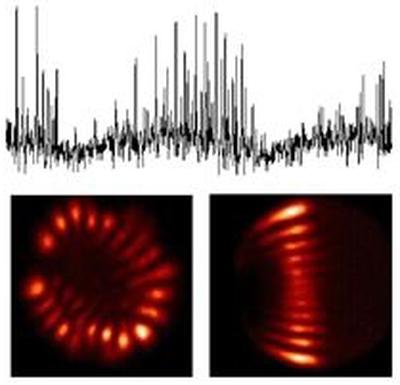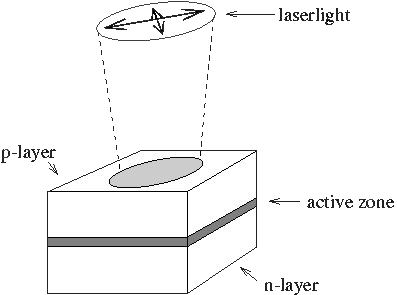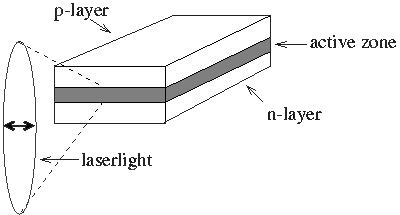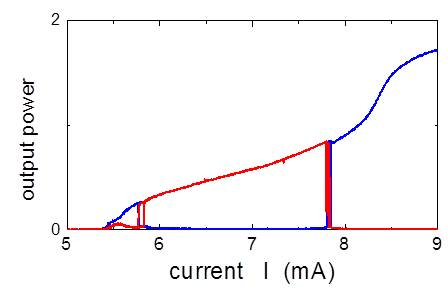Nonlinear Laser Dynamics and Spin VCSELs

Introduction
Semiconductor laser diodes are ubiquitous nowadays in scientific and commercial applications such as high-speed data transmission, laser pumping and spectroscopy as well as in everyday life (CD-players, laser printers). Nevertheless – due to the high complexity of the nonlinear processes in the semiconductor itself as well as in the light-matter interaction – the understanding of many dynamical phenomena in semiconductor laser devices is far from complete.
Vertical-cavity surface-emitting lasers (VCSELs) are a rather new type of semiconductor laser diode, in which – in contrast to conventional edge emitters – the direction of the light emission is parallel to the epitaxial growth direction. The advantageous properties of this design resulted in a large interest in applied as well as in pure research. In particular, one can achieve single-longitudinal mode emission due to a short cavity length, a low threshold current density and a rotationally symmetric shape of the active zone, which in turn implies the possibility of a circular emission profile. The latter is very important in many applications, e.g. in fiber coupling.


However, the very same design properties, which make VCSELs so interesting for applications, imply also a high vulnerability to instabilities. In particular, the high degree of symmetry and the potentially large transverse extent of the active zone implies that a lot of degrees of freedom can be excited which differ in their spatial structure and/or in their polarization properties. These instabilities limit the power and/or the coherence of the emitted laser beam. Due to the characteristics of the dielectric susceptibility of semiconductor lasers one has also to be aware of the possibility of temporal dynamics on very different time scales, including very short ones (ps). Thus, VCSELS are a technologically relevant system with complex nonlinearities in which basic properties are determined by self-organization phenomena in space, time and polarization. A thorough understanding of these phenomena is expected to help in improving commercial systems in the long run. Therefore, an important aim of the research is the development of control schemes. The control of spatio-temporal structures is also one of the important and unsolved problems in fundamental research on spontaneous pattern formation.
Moreover there is a strong connection between the carrier spin and the polarization of the emitted light, a feature which can be crucial for many new applications. Spin optolectronics is part of the emerging field of spintronics, which aims at using the spin degree of freedom of carriers for information storage and processing in addition to carrier number in traditional electronics, and involves the generation, transport, manipulation and detection of spin currents.
Polarization dynamics, spin lasers and ultrafast self-oscillations
Due to the isotropy in the plane of the active zone the direction of polarization is not or only weakly pinned so that VCSELs are very sensitive to polarization instabilities. In real device there are some preferred directions due to strain from contacting or from growth imperfections and from the electro-optical effect. Therefore typically a state with a defined linear polarization emerges at threshold, which is however not stable but gives way to the orthogonal one as the current is increased. Furthermore, it was noted that the primary polarization can be recovered after a second polarization switching.

A VCSEL switching back and forth between two orthogonal linear polarization states (red and blue lines). See Phys. Rev. A 68, 033822 (2003) for details.
Many aspects of this switching behaviour can be understood by considering linear (i.e. unsaturated), but temperature dependent gain or loss anisotropies for the two polarization modes which are frequency split by birefringence. However, our experiments yielded the
- emergence of elliptically polarized states (“phase instability”),
- spontaneous self-oscillation of polarization state with a frequency of a few GHz,
- polarization switching with a drop in total output power, i.e. to a mode with a lower unsaturated net gain.
These observations provide strong evidence for the relevance of spin dependent nonlinearities, i.e. the need for a model that allows for a description of the phase of the optical field (i.e. a model which goes beyond intensity rate equations) and for the selection of a polarization mode which is not the one favoured by the unsaturated gain-loss balance. These prerequisites are fulfilled in the so-called spin-flip model (SFM) which takes into account explicitly the spin degrees of freedom of a semiconductor quantum well. Here polarization selection is explained by an interplay of spin relaxation, saturable dispersion, which is very pronounced in semiconductor lasers due to the strong coupling between amplitude and phase, birefringence and dichroism. The experimental results are found to be consistent with the model, if a low spin-flip rate is assumed. The results establish the relevance of spin degrees of freedom for VCSEL dynamics at room temperature and the high carrier densities needed for lasing.
This research led – in collaboration with the University of Bochum – to the demonstration of ultra-fast self-oscillations of the polarization states of VCSELs. The frequency of the oscillations is controlled by the birefringence of the VCSEL microcavity and was 11-12 GHz in the proof-of-principle experiment, but is anticipated to provide a mechanism for self-oscillation beyond 100 GHz. This provides an attractive route to circumvent the operational speed limit of directly modulated semconductor lasers imposed by the relatively long carrier lifetime and the resulting damping of relaxation oscillations.

Self-oscillations of the circular polarization degree after perturbation of a VCSEL electrically biased at the polarization switching point with a short puls providing a spin polarization. See App. Phys. Lett. 99, 151107 (2011) for details.
Feedback dynamics
Another important aspect of our work is the characterization of the polarization dynamics of VCSELs with feedback from a distant reflector. This situation is very interesting from a nonlinear dynamics point of view and its understanding is crucial for applications, since feedback arises nearly inevitably in typical operating conditions of semiconductor lasers and usually results in instabilities and increased noise. In the special case of VCSELs, a thorough understanding of the polarization properties with optical feedback might also open the possibility of new – polarization based – sensors.
A particularly intriguing phenomenon are the so-called “low-frequency fluctuations” (LFF). They consist of sudden drops in the output power followed by a slow recovery. The time scale is of the order of some tens or hundreds of nanoseconds and thus much longer than the feedback time and the intrinsic time scales of a semiconductor laser, which explains the name “low-frequency”. They were observed first more than 25 years ago but their properties and origin are still a matter of intensive discussion. Our experiments yielded the
- demonstration of the existence of LFF in VCSELs,
- the amount of participation of both polarization mode depends on the dichroism of the free running device,
- different synchronization behaviour between polarization modes on different time scales and in dependency on parameters,
- change of correlation properties at different multiples of the round-trip frequency in analogy of the phase-envelope slippage known in mode-locked lasers.
- The properties of LFF do not differ qualitative between the case that one polarization mode is excited or both. This clarifies a parallel discussion on LFF in edge-emitting lasers and the relevance of multi-longitudinal mode behavior.
Many aspects of the observed dynamics can be reproduced qualitatively by considering the SFM-model with feedback terms.
Spatio-temporal structures in broad-area VCSELs
VCSELs are very short, typically the inner spacer layer is only one wavelength long (about 200-250 nm) and the effective cavity length is slightly larger than one micrometer. This has the advantage that VCSELs operate intrinsically in single longitudinal mode. On the other hand, this implies that VCSELs have a rather large Fresnel number, i.e. their longitudinal dimension is considerably smaller than the transverse size (about 10-20 µm for typical commercial lasers and up to about 200 µm for prototypes investigated for high-power applications as free space communication, sensors, printing and laser pumping). Hence the spatial and temporal coherence and/or the available output power are limited by spatial instabilities, i.e. a very strong tendency for the excitation of transverse modes (potentially of very high order). These spatial instabilities can be regarded also as a manifestation of self-organization, i.e. spontaneous pattern formation. A particularly intriguing aspect of VCSEL patterns is that these structures open also a simple access for studying the relation between wave and ray optics, quantum and classically trajectories respectively, in billiard problems, where the reflective boundaries are created by refractive index steps determining the size of the active aperture. This provides a link to the very active field of wave or quantum chaos.
We are studying the formation and characteristics of spatial structures in broad-area VCSELs are studied and control strategies are developed in order to stabilize and to steer their output in a well defined emission state. Recent focus is on the coupling between spatial and polarization degrees of freedom and the understanding of the relationship between the self-organization and the quantum chaos approach to pattern formation. Click here for information on aspects of broad-area VCSELs and solitons.
Our investigations yielded the:
-
quantitative confirmation of the expected square-root scaling law between wavenumber and detuning in off-axis lasing Fourier modes in square and circular VCSELs, (Appl. Phys. B 2005 \ Appl. Phys. B 2009). (Institutional Repository. 2005 \ 2009)
-
an understanding of the complex polarization selection in ‘quantum billiard’ states in broad-area VCSELs stemming from an interplay between the anisotropy of the reflection at the distributed Bragg reflectors and the side boundaries and a justification for the phenomenological construction of coherent states to explain billiard states (see Phys. Rev. Lett. 2008) . (Institutional Repository)
-
understanding of differences between below and above threshold polarization selection in off-axis modes of square and circular broad-area VCSELs.
Publications “Control of broad-area lasers”
- Demonstration experiment on suppression of high-order modes via intra-cavity transverse periodic modulations of refractive index (Appl. Phys. Lett. 2008, Institutional Repository)
- Characterization of inhomogeneities and disorder in broad-area VCSELs (Opt. Lett. 2012, Institutional Repository)
- Modal control of broad-area VCSELs by feedback (J. Phys. D 2009, Institutional Respository)
- Demonstration of a tunable, narrow linewidth quantum dot laser based on feedback to a broad-area edge-emitting laser (Appl. Phys. B 2007, Institutional Repository)
Coverage and Esteem
- Invited talk on Beam quality enhancement of broad-area diode lasers with two-dimensional gain modulation at NDSL16 – International Workshop: Nonlinear Dynamics in Semiconductor Lasers, Berlin, Germany, June 15-17, 2016.
- Invited lectures on broad-area lasers and laser solitons at ICTP-SAIFR School on Nonlinear Optics and Nanophotonics, IFT-UNESP, Sao Paulo, Brazil (Dec 2013).
- Invited lecture: Dissipative solitons and spatial structures in optical systems at Photonics@be Doctoral School
People
- Prof. Thorsten Ackemann
- Martin Hofmann (RU Bochum)
- S. Balle (UIB, Palma de Mallorca)
- M. Sorel (Electronic and Nanoscale Engineering, U Glasgow)
- Computational Nonlinear Optics and Quantum Optics Group (Strathclyde)
Former Group Members and Collaborators
- Dr. N. Radwell
- Group of N. A. Loiko (Belorussian Academy of Science, Minsk)
- Dr. Y. Tanguy
- K. F. Huang (Department of Electrophysics, National Chiao Tung University, Hsinchu, Taiwan)
- Dr. Malte Schulz-Ruhtenberg (University of Muenster)
- R. Jaeger (Ulm Photonics)
- Dr. Markus Sondermann (University of Muenster)
- C. Denz (Institut fuer Angewandte Physik, University of Muenster)
Funding
- Deutsche Forschungsgemeinschaft Ac 85/5-2 04/2004 – 09/2007
- EU-STREP 4868 FunFACS: Fundamentals, Functionalities and Applications of Cavity Solitons 04/2005 – 09/2008
- British Council ARC grant 1267 08/2006 – 07/2008